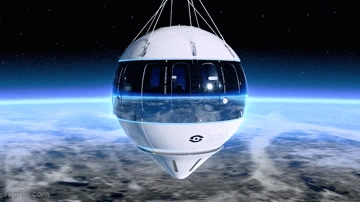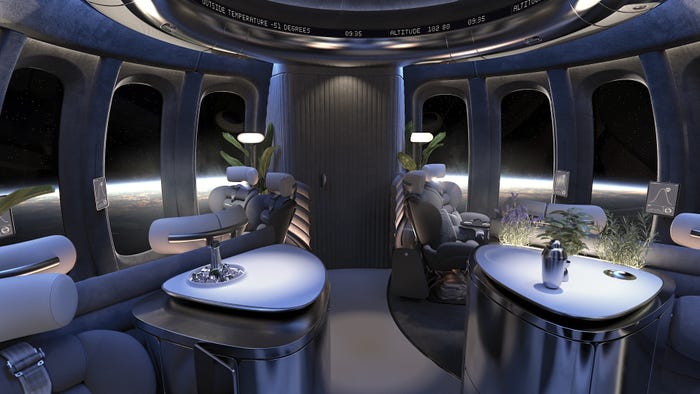
At a Glance
- $125,000 vs. $450,000
- 6-hour flight vs. 15-minute flight
- 19 miles high vs. 50 miles or 65 miles
While Blue Origin and Virgin Galactic have revolutionized the concept of tourist space flight with their reusable rockets, seats on those flights still run nearly half a million dollars for their brief sub-orbital hops that last only minutes.
The flights consume huge amounts of fuel and produce prodigious volumes of CO2 and the rough ride to space and back is familiar to filmgoers who remember movies like Apollo 13.
Florida-based Space Perspective seeks to offer an alternative…perspective, on the experience of flying to space. In place of rocket boosters, the Space Perspective Spaceship Neptune carries passengers into the blackness of space beneath the kind of hydrogen-filled balloon that is commonly used for high-altitude research.
That altitude is “only” 100,000 feet. That’s 19 miles, not the 100 kilometers, or 62 miles of the Karman line that commonly defines space. Blue Origin’s New Shepard flies to 65 miles but spends only about four minutes in space before falling back to Earth.
Virgin Galactic flies its Spaceship 2 passengers to more than 50 miles, which falls short of the usual definition of space flight, though it surely delivers the black-sky-curved-earth experience. Passengers have small portholes to peer through during their short time in flight.
A Balloon Instead
Space Perspective’s balloon provides a six-hour flight with a smooth 12-mph take-off and a gentle splash down at the end.
The 16-foot diameter carbon composite Neptune capsule carries an array of 52-inch windows that provide the capsule’s eight paying passengers (fare is $125,000) expansive views of Earth and space. Spaceship Neptune is spherical because the inherent strength of the sphere offered irresistible benefits, reported lead capsule designer Dan Window in an interview with Design News.
The company was contemplating something zoomier in shape, but reality won in the end. “Fundamentally, it is a pressure vessel, which affects the aesthetic, to be a sphere,” he said. “We were thinking something more proportional.”
“When we looked at the engineering, it allows you to make the structure a lot lighter than if you do anything that is not spherical,” he concluded. The simplicity of the sphere is also in line with the vehicle’s overall design philosophy of simplicity.
This simplicity provides reliability and safety, said Window. The sphere is made of carbon fiber composite material by Space Perspective in-house at its headquarters. The company has run many simulations on the design to ensure its safety and will conduct a flight test with a load of computers aboard in the near future. “There will be rack servers for test equipment,” inside the capsule for the first flight, he said.
Splash Down
Beneath the capsule’s spherical pressure vessel, Spaceship Neptune has a splash cone to smooth its entry into the ocean on return. Space Perspective will launch its balloons from a ship because this simplifies operations, as the balloon doesn’t have to be steered carefully and the ship can leave Florida to offer launches from other locations in the future if needed.
So while balloons can easily land on land, launching from a ship at sea makes a water landing necessary. For the splash cone, the team considered a variety of solutions. “We went through every kind of iteration of what the cone could look like,” said Window.
“That was a really interesting thing, to come up with a many interesting ways to do a cone as possible. We put designs through the simulation tests to see how that would affect the capsule.”
The cone not only smooths the impact with the water’s surface, but it also floods with seawater to provide ballast for the capsule, acting as a sea anchor for Spaceship Neptune.
Window Work
The capsule’s defining feature is its array of large windows. “The windows are a huge part of the design,” said the coincidentally named designer, Window. “The journey itself is what you’re paying for and ultimately it is the windows that offer that experience.”
But, as he said, Spaceship Neptune is a pressure vessel, so the windows and their openings need to be strong enough to be safe. “I know that on this project there are huge margins of safety,” he said.
Space Perspective turned to plastics specialist Llamas Plastics, Inc. to develop the windows. “The windows are big,” observed Llamas Plastics general manager Gary Koshak in a YouTube video posted by Space Perspective. “They aren’t little portholes.”
In addition to the structural considerations, there are also thermal issues that come from having the capsule blasted by direct, unfiltered sunlight. “Because you’re flying at 100,000 feet, what we had to do was build a coating that would reflect the UV rays, that would reflect that energy so it wouldn’t absorb it into the aircraft and heat up the capsule,” he said.
“We’re one of four companies in the world that can do some of these special vacuum chamber coatings,” explained Micah Llamas, the company’s coating engineer/supervisor. “We developed that with Space Perspective’s team to come up with this new coating for the spaceship Neptune.”
“Developing a coating that can reflect light and also to have very good optics is the main challenge that we overcame,” he continued. “We have three large vacuum chambers here that we use for putting on thin-film coating in a vacuum setting.”
That reflective coating will help prevent the capsule’s occupants from baking in the sun during their flight. “One side can be really hot and one side can be near sub-zero range,” said Space Perspective Thermal and fluids engineer Royce Fernandez.

The only "right stuff" needed for the Space Perspective flight might be a bottle of bubbly. SPACE PERSPECTIVE
Comfort First
With the temperature managed, passengers can spread out and enjoy their flight in the spacious, comfortable cabin. No space suits are required, and the cabin features comfortable seating in place of the seats used in rocket-powered spacecraft with their high-g launches and re-entries.
Spaceship Neptune’s pressurized volume of 2,000 cubic feet is double that of Virgin Galactic’s Spaceship Two and Blue Origin’s New Shepard. It even includes a bathroom!
Space Perspective builds its custom-made SpaceBalloon in a 700-foot-long factory, with the huge balloon spread over tables running the whole length, said Window. The flight electrical and power systems, software, mission control and the environmental control, and life support systems are all also made in-house by Space Perspective.
The company says that it has 1,750 current ticket holders and forecasts reaching 4,000 seats sold by the end of the year. Completing the upcoming test flight will surely spark interest, even if this flight only carries racks of computers that will surely not appreciate their experience. Maybe one of the computers should run an AI.
About the Author(s)
You May Also Like





